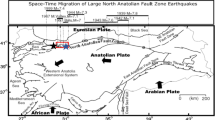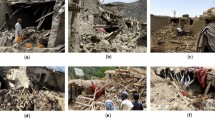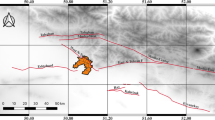Abstract
Estimation of seismic losses is a fundamental step in risk mitigation in urban regions. Structural damage patterns depend on the regional seismic properties and the local building vulnerability. In this study, a framework for seismic damage estimation is proposed where the local building fragilities are modeled based on a set of simulated ground motions in the region of interest. For this purpose, first, ground motion records are simulated for a set of scenario events using stochastic finite-fault methodology. Then, existing building stock is classified into specific building types represented with equivalent single-degree-of-freedom models. The response statistics of these models are evaluated through nonlinear time history analysis with the simulated ground motions. Fragility curves for the classified structural types are derived and discussed. The study area is Erzincan (Turkey), which is located on a pull-apart basin underlain by soft sediments in the conjunction of three active faults as right-lateral North Anatolian Fault, left-lateral North East Anatolian Fault, and left-lateral Ovacik Fault. Erzincan city center experienced devastating earthquakes in the past including the December 27, 1939 (Ms = 8.0) and the March 13, 1992 (Mw = 6.6) events. The application of the proposed method is performed to estimate the spatial distribution of the damage after the 1992 event. The estimated results are compared against the corresponding observed damage levels yielding a reasonable match in between. After the validation exercise, a potential scenario event of Mw = 7.0 is simulated in the study region. The corresponding damage distribution indicates a significant risk within the urban area.






(adopted from Ibarra et al. (2005))









Similar content being viewed by others
References
Akinci A, Malagnini L, Herrmann RB, Pino NA, Scognamiglio L, Eyidogan H (2001) High-frequency ground motion in the Erzincan region, Turkey: inferences from small earthquakes. Bull Seismol Soc Am 91(6):1446–1455. https://doi.org/10.1785/0120010125
Akkar S, Sucuoğlu H, Yakut A (2005) Displacement-based fragility functions for low and mid-rise ordinary concrete buildings. Earthq Spectra 21(4):901–927. https://doi.org/10.1193/1.2084232
Akyuz HS, Hartleb R, Barka A, Altunel E, Sunal G, Meyer B, Armijo R (2002) Surface rupture and slip distribution of the 12 November 1999 Düzce earthquake (M 7.1), North Anatolian fault, Bolu, Turkey. Bull Seismol Soc Am 92(1):61–66. https://doi.org/10.1785/0120000840
Anderson JG, Hough SE (1984) A model for the shape of the Fourier amplitude spectrum of acceleration at high frequencies. Bull Seismol Soc Am 74(5):1969–1993
Askan A, Yucemen MS (2010) Probabilistic methods for the estimation of potential seismic damage: application to reinforced concrete buildings in Turkey. Struct Saf 32(4):262–271. https://doi.org/10.1016/j.strusafe.2010.04.001
Askan A, Sisman FN, Ugurhan B (2013) Stochastic strong ground motion simulations in sparsely monitored regions: a validation and sensitivity study on the 13 March 1992 Erzincan (Turkey) earthquake. Soil Dyn Earthq Eng 55:170–181. https://doi.org/10.1016/j.soildyn.2013.09.014
Askan A, Asten M, Erberik MA, Erkmen C, Karimzadeh S, Kilic N, Sisman FN, Yakut A (2015a) Seismic damage assessment of Erzincan, Turkish national union of geodesy and geophysics project. Project no: TUJJB-UDP-01-12, Ankara
Askan A, Karimzadeh S, Asten M, Kiliç N, Sisman FN, Erkmen C (2015b) Assessment of seismic hazard in the Erzincan (Turkey) region: construction of local velocity models and evaluation of potential ground motions. Turk J Earth Sci 24(6):529–565. https://doi.org/10.3906/yer-1503-8
ATC (1996) Seismic evaluation and retrofit of concrete buildings. ATC-40, Applied Technology Council, Redwood City, 1
Bal IE, Bommer JJ, Stafford PJ, Crowley H, Pinho R (2010) The influence of geographical resolution of urban exposure data in an earthquake loss model for Istanbul. Earthq Spectra 26(3):619–634. https://doi.org/10.1193/1.3459127
Beresnev I, Atkinson GM (1964) Modeling finite-fault radiation from the ω n spectrum. Bull Seismol Soc Am 87(1):67–84
Biggs JM (1964) Introduction to structural dynamics. McGraw Hill Company, New York, p 3
Boore DM (1983) Stochastic simulation of high-frequency ground motions based on seismological models of the radiated spectra. Bull Seismol Soc Am 73(6A):1865–1894
BSSC (1997) NEHRP guidelines for the seismic rehabilitation of buildings. FEMA-273, developed by ATC for FEMA, Washington, DC
Clough R, Johnston SB (1966) Effect of stiffness degradation on earthquake ductility requirements. In: Proceedings, 2nd Japan national conference on earthquake engineering, pp 227–232
Erberik MA (2008a) Fragility-based assessment of typical mid-rise and low-rise RC buildings in Turkey. Eng Struct 30(5):1360–1374. https://doi.org/10.1016/j.engstruct.2007.07.016
Erberik MA (2008b) Generation of fragility curves for Turkish masonry buildings considering in-plane failure modes. Earthq Eng Struct D 37(3):387–405. https://doi.org/10.1002/eqe.760
Erdik M, Yüzügüllü O, Karakoc Yilmaz C, Akkas N (1994) March 13, 1992 Erzincan (Turkey) earthquake. In: Earthquake engineering 10th world conference
Fajfar P, Fischinger M (1988) N2—a method for non-linear seismic analysis of regular structures. In: Proceedings of the 9th world conference on earthquake engineering, vol 5, pp 111–116
Frankel A (1993) Three-dimensional simulations of the ground motions in the San Bernardino valley, California, for hypothetical earthquakes on the San Andreas Fault. Bull Seismol Soc Am 83(4):1020–1041
Gürpinar A, Abali M, Yücemen MS, Yesilcay Y (1978) Feasibility of obligatory earthquake insurance in Turkey. Earthquake Engineering Research Center, Civil Engineering Department, Middle East Technical University, Ankara 78-05 (in Turkish)
Hartzell SH (1978) Earthquake aftershocks as Green’s functions. Geophys Res Lett 5(1):1–4. https://doi.org/10.1029/GL005i001p00001
Hsieh MH, Lee BJ, Lei TC, Lin JY (2013) Development of medium-and low-rise reinforced concrete building fragility curves based on Chi–Chi Earthquake data. Nat Hazards 69(1):695–728. https://doi.org/10.1007/s11069-013-0733-8
Ibarra LF, Krawinkler H (2005) Global collapse of frame structures under seismic excitations. Rep. no. TB 152, The John A. Blume Earthquake Engineering Center, Stanford University, Stanford
Ibarra LF, Medina RA, Krawinkler H (2005) Hysteretic models that incorporate strength and stiffness deterioration. Earthq Eng Struct D 34(12):1489–1511. https://doi.org/10.1002/eqe.495
Kamae K, Irikura K, Pitarka A (1998) A technique for simulating strong ground motion using Hybrid Green’s function. Bull Seismol Soc Am 88(2):357–367
Kappos AJ, Stylianidis KC, Pitilakis K (1998) Development of seismic risk scenarios based on a hybrid method of vulnerability assessment. Nat Hazards 17(2):177–192. https://doi.org/10.1023/A:1008083021022
Karimzadeh S, Askan A, Erberik MA, Yakut A (2015) Multicomponent seismic loss estimation on the North Anatolian Fault Zone (Turkey). Paper no.: NH13B-1920, American Geophysical Union, San Francisco
Kircil MS, Polat Z (2006) Fragility analysis of R/C frame buildings. Eng Struct 28(9):1335–1345
Lang DH, Molina S, Lindholm CD (2008) Towards near-real-time damage estimation using a CSM-based tool for seismic risk assessment. J Earthq Eng 12(S2):199–210. https://doi.org/10.1080/13632460802014055
Lignos DG, Krawinkler H (2010) Deterioration modeling of steel components in support of collapse prediction of steel moment frames under earthquake loading. J Struct Eng 137(11):1291–1302. https://doi.org/10.1061/(ASCE)ST.1943-541X.0000376
Lignos DG, Krawinkler H (2012) Development and utilization of structural component databases for performance-based earthquake engineering. J Struct Eng 139(8):1382–1394. https://doi.org/10.1061/(ASCE)ST.1943-541X.0000646
Mai PM, Imperatori W, Olsen KB (2010) Hybrid broadband ground-motion simulations: Combining long-period deterministic synthetics with high-frequency multiple S-to-S back-scattering. Bull Seismol Soc Am 100(5A):2124–2142. https://doi.org/10.1785/0120080194
Mohammadioun B, Serva L (2001) Stress drop, slip type, earthquake magnitude, and seismic hazard. Bull Seismol Soc Am 91(4):694–707. https://doi.org/10.1785/0120000067
Motazedian D, Atkinson GM (2005) Stochastic finite-fault modeling based on a dynamic corner frequency. Bull Seismol Soc Am 95(3):995–1010. https://doi.org/10.1785/0120030207
Olsen KB, Archuleta RJ, Matarese JR (1996) Three-dimensional simulation of a magnitude 7.75 earthquake on the San Andreas fault. Science 270(5242):1628
OpenSees 2.4.5, Computer Software, University of California, Berkeley. http://opensees.berkeley.edu. Accessed 12 Dec 2014
Pitarka A, Somerville P, Fukushima Y, Uetake T, Irikura K (2000) Simulation of near-fault strong ground motion using Hybrid Green’s functions. Bull Seismol Soc Am 90(3):566–586. https://doi.org/10.1785/0119990108
Qi X, Moehle JP (1991) Displacement design approach for reinforced concrete structures subjected to earthquakes. Earthquake Engineering Research Center, College of Engineering/University of California, 91:(2)
Saiidi M, Sozen MA (1981) Simple nonlinear seismic analysis of R/C structures. J Struct Div 107(5):937–953
Şengezer BS (1993) The damage distribution during March 13, 1992 Erzincan earthquake. In: Proceedings. 2nd national earthquake engineering conference, pp 404–415
Sørensen MB, Lang DH (2014) Incorporating simulated ground motion in seismic risk assessment-application to the lower Indian himalayas. Earthq Spectra 31(1):71–95. https://doi.org/10.1193/010412EQS001M
Sucuoğlu H, Tokyay M (1992) 13 Mart 1992 Erzincan earthquake engineering report. Civil Engineering Department, Ankara, p 102
Tesfamariam S, Goda K (2015) Loss estimation for non-ductile reinforced concrete building in Victoria, British Columbia, Canada: effects of mega-thrust Mw9-class subduction earthquakes and aftershocks. Earthq Eng Struct D 44(13):2303–2320. https://doi.org/10.1002/eqe.2585
TUIK. http://www.tuik.gov.tr/Web2013/iletisim/iletisim.html. Accessed 19 Sept 2013
Ucar T, Duzgun M (2013) Derivation of analytical fragility curves for RC buildings based on nonlinear pushover analysis. IMO Teknik Dergi 24(3):6421–6446 (In Turkish)
Ugurhan B, Askan A (2010) Stochastic strong ground motion simulation of the 12 November 1999 Düzce (Turkey) earthquake using a dynamic corner frequency approach. Bull Seismol Soc Am 100(4):1498–1512. https://doi.org/10.1785/0120090358
Ugurhan B, Askan A, Erberik MA (2011) A methodology for seismic loss estimation in urban regions based on ground-motion simulations. Bull Seismol Soc Am 101(2):710–725. https://doi.org/10.1785/0120100159
Wells DL, Coppersmith KJ (1994) New empirical relationships among magnitude, rupture length, rupture width, rupture area and surface displacement. Bull Seismol Soc Am 84(4):974–1002
Whitman RV, Anagnos T, Kircher CA, Lagorio HJ, Lawson RS, Schneider P (1997) Development of a national earthquake loss estimation methodology. Earthq Spectra 13(4):643–661. https://doi.org/10.1193/1.1585973
Yakut A, Ozcebe G, Yucemen MS (2006) Seismic vulnerability assessment using regional empirical data. Earthq Eng Struct Dyn 35(10):1187–1202. https://doi.org/10.1002/eqe.572
Yong C, Ling C, Güendel F, Kulhánek O, Juan L (2002) Seismic hazard and loss estimation for Central America. Nat Hazards 25(2):161–175. https://doi.org/10.1023/A:1013722926563
Acknowledgements
This study is partially funded by Turkish National Geodesy and Geophysics Union through the Project with Grant No. TUJJB-UDP-01-12.
Author information
Authors and Affiliations
Corresponding author
Rights and permissions
About this article
Cite this article
Karimzadeh, S., Askan, A., Erberik, M.A. et al. Seismic damage assessment based on regional synthetic ground motion dataset: a case study for Erzincan, Turkey. Nat Hazards 92, 1371–1397 (2018). https://doi.org/10.1007/s11069-018-3255-6
Received:
Accepted:
Published:
Issue Date:
DOI: https://doi.org/10.1007/s11069-018-3255-6




